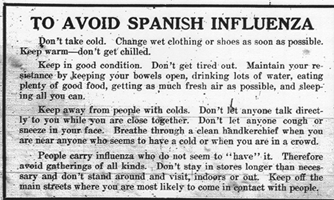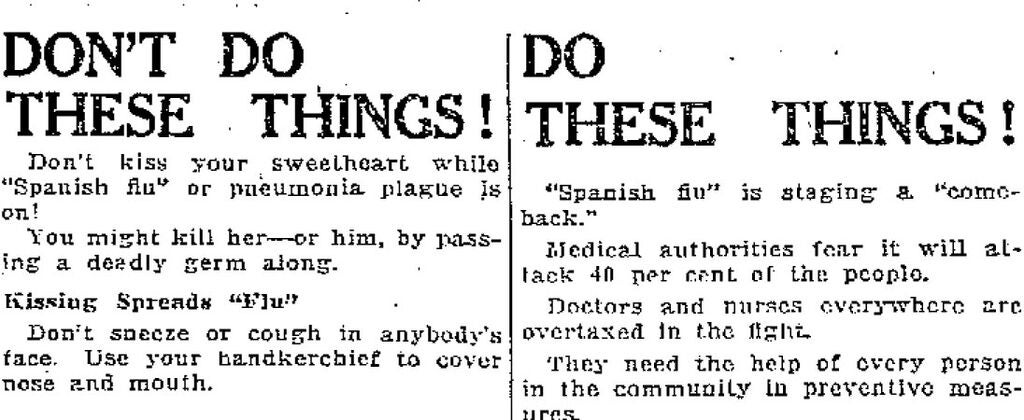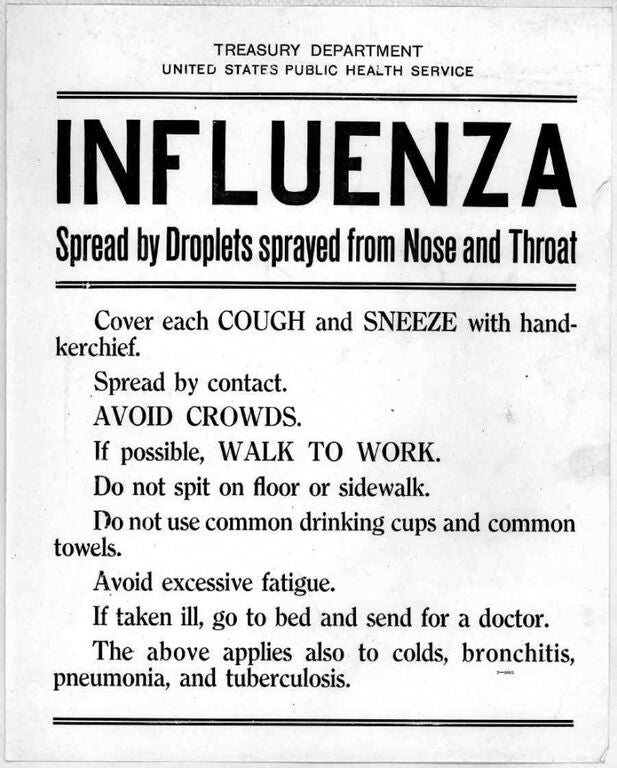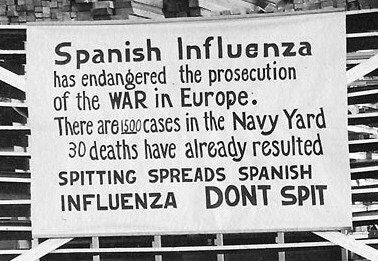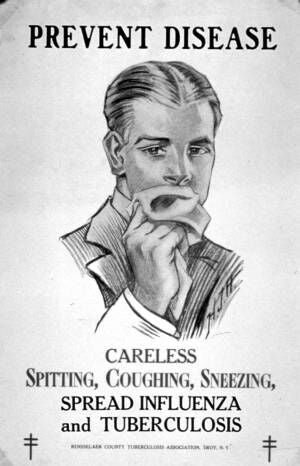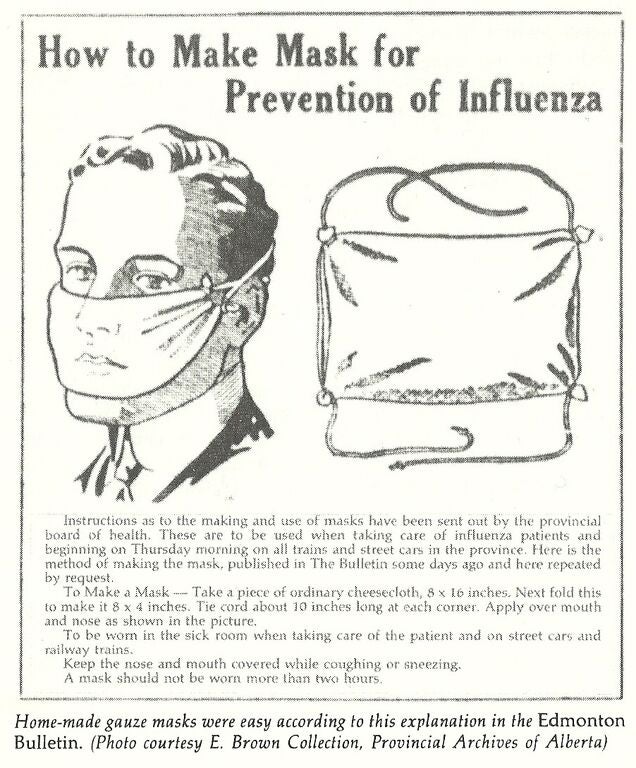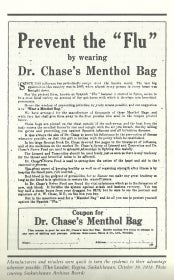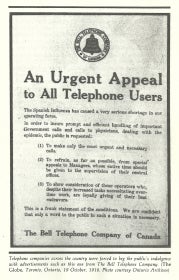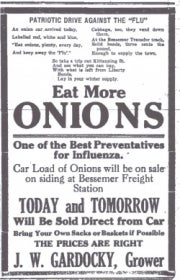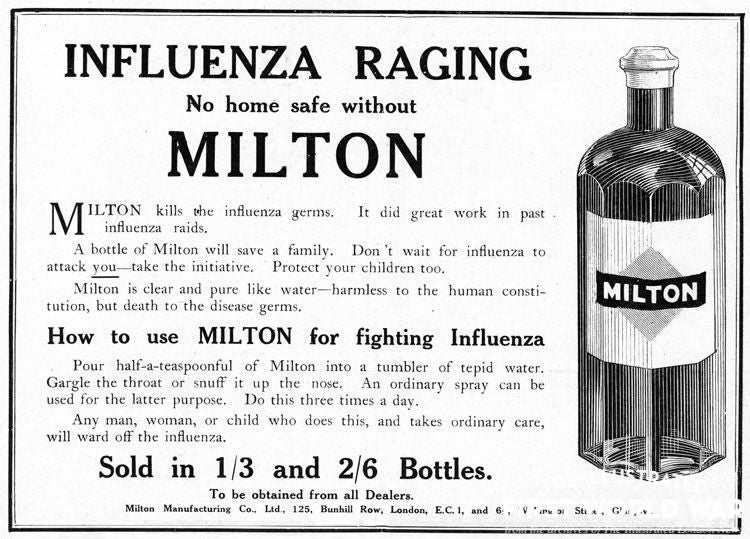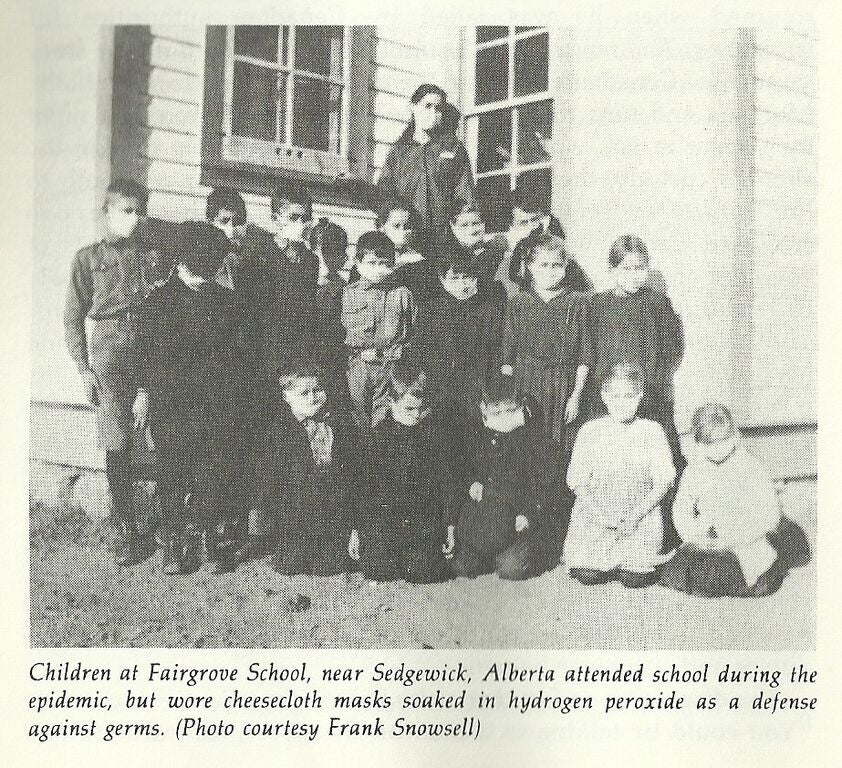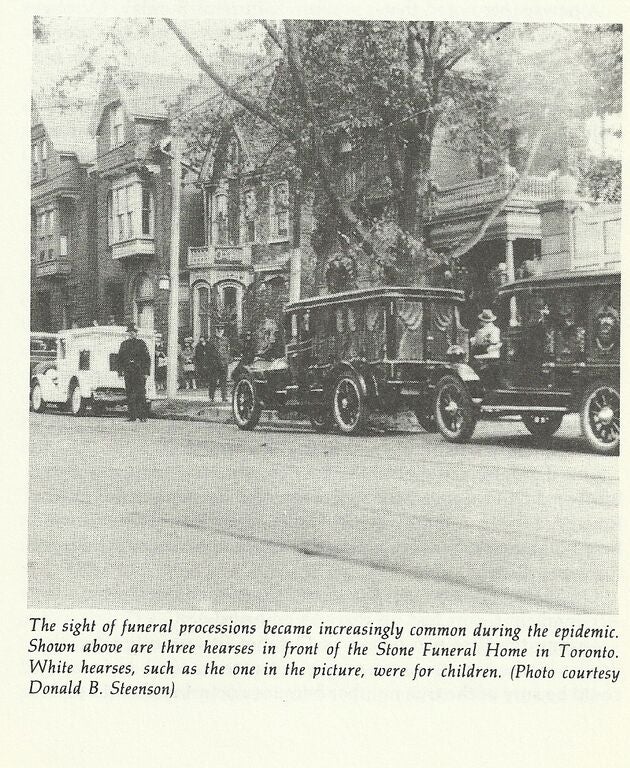Home | Contagion, Pandemics and Humanity | Geography | Gallery | The End of Days | The Prairies | World War I | The War Effort at Home
The content on this page was gathered and posted by students of the dramaturgy course associated with the departmental production of Unity 1918. The images on this page are not sourced from the University of Waterloo Library.
"You might notice a dull headache. Your eyes might start to burn. You start to shiver and you will take to your bed, curling up in a ball. But no amount of blankets can keep you warm. You fall into a restless sleep, dreaming the distorted nightmares of delirium as your fever climbs. And when you drift out of sleep, into a sort of semi-consciousness, your muscles will ache and your head will throb and you will somehow know that, step by step, as your body feebly cries out "no," you are moving steadily toward death.
"It may take a few days, it may take a few hours, but there is nothing that can stop the disease's progress. Doctors and nurses have learned to spot the signs. Your face turns a dark brownish purple. You start to cough up blood. Your feet turn black. Finally, as the end nears, you frantically gasp for breath. A blood-tinged saliva bubbles out of your mouth. You die—by drowning, actually—as your lungs fill with a reddish fluid."
Gina Kolata, from The Story of the Great Influenza Pandemic of 1918 and the Search for the Virus That Caused It
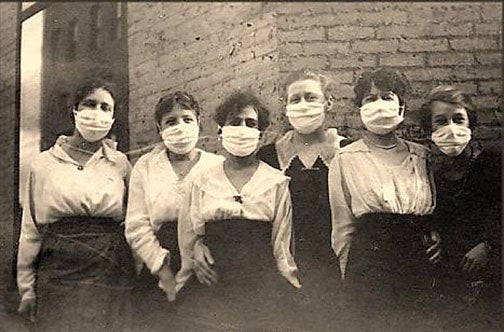
Photo source: State Library of Queensland, Australia.
Introduction on the Spanish Flu in Canada from the Canadian War Museum...
The war ended with a raging influenza epidemic, spread through Canada in part by infected soldiers returning from overseas.
A Global Killer
The Spanish influenza epidemic, was a uniquely lethal virus that attacked healthy young bodies between the ages of 20 to 40, with the highest mortality rate between the ages of 21 and 29. From the middle of 1918 to early 1919, the flu killed at least 20 million people worldwide, including an estimated 50,000 Canadians.
The flu came in three waves: the first in the spring of 1918, the second (and most lethal) in late August and the final wave in the winter of 1918-1919. The flu was spread through bodily fluids and moved quickly through the population. It presented itself through fatigue and cough, but quickly attacked the body, creating mucous build-up in the lungs that could not be expelled. Victims of the flu could be dead within a day of contracting the illness.
Contrary to its name, the Spanish Flu is not Spanish at all. Wartime censorship meant that the combatant governments of World War I did not release any information about the flu in an effort to maintain citizen morale. Spain, a neutral party during the war, had no reason to impose censorship, leaving Spanish newspapers free to report on infected citizens. As a result, Spain was tagged as the origin of the virus (Dehner,42).
"The 1918 has gone: a year momentous as the termination of the most cruel war in the annals of the human race; a year which marked, the end at least for a time, of man's destruction of man; unfortunately a year in which developed a most fatal infectious disease causing the death of hundreds of thousands of human beings. Medical science for four and one-half years devoted itself to putting men on the firing line and keeping them there. Now it must turn with its whole might to combating the greatest enemy of all--infectious disease," (12/28/1918).
The Flu in Canada
Canada’s flu dead included soldiers who had survived the fighting overseas only to succumb to illness once in Canada and thousands of family members who welcomed them home but perished soon after their arrival.
The loss of so many Canadians had a profound social and economic impact on a country that had already suffered 60,000 war dead. The combined death toll significantly reduced the workforce. It left thousands of families without a primary wage earner and orphaned thousands of children.
In attempting to halt the spread of the disease, many local governments shut down non-essential services. Provinces imposed quarantines and protective masks were required in public places. The epidemic led directly to the formation of the federal Department of Health in 1919.
Below: a timeline for the Spanish Flu in British Columbia; sourced from O’Keefe, Betty, and Ian Macdonald. Dr. Fred and the Spanish Lady: Fighting the Killer Flu. Surrey, BC: Heritage House, 200. pp21-22.
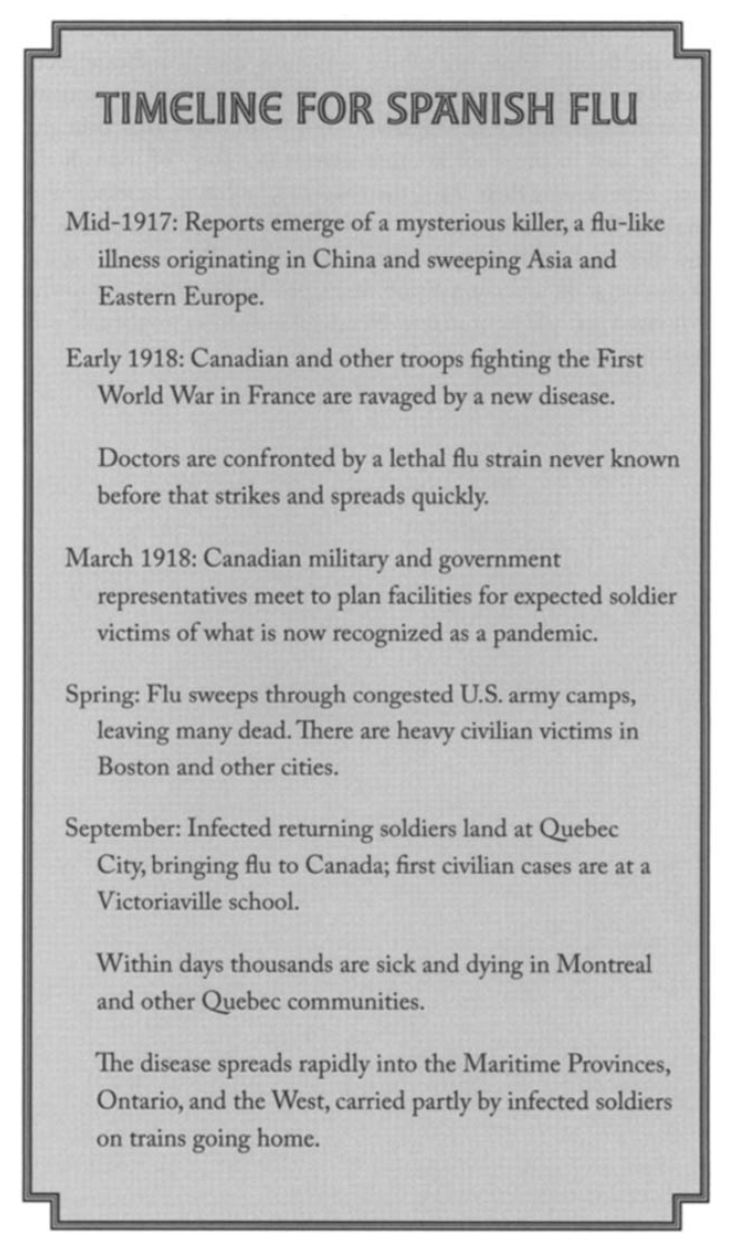
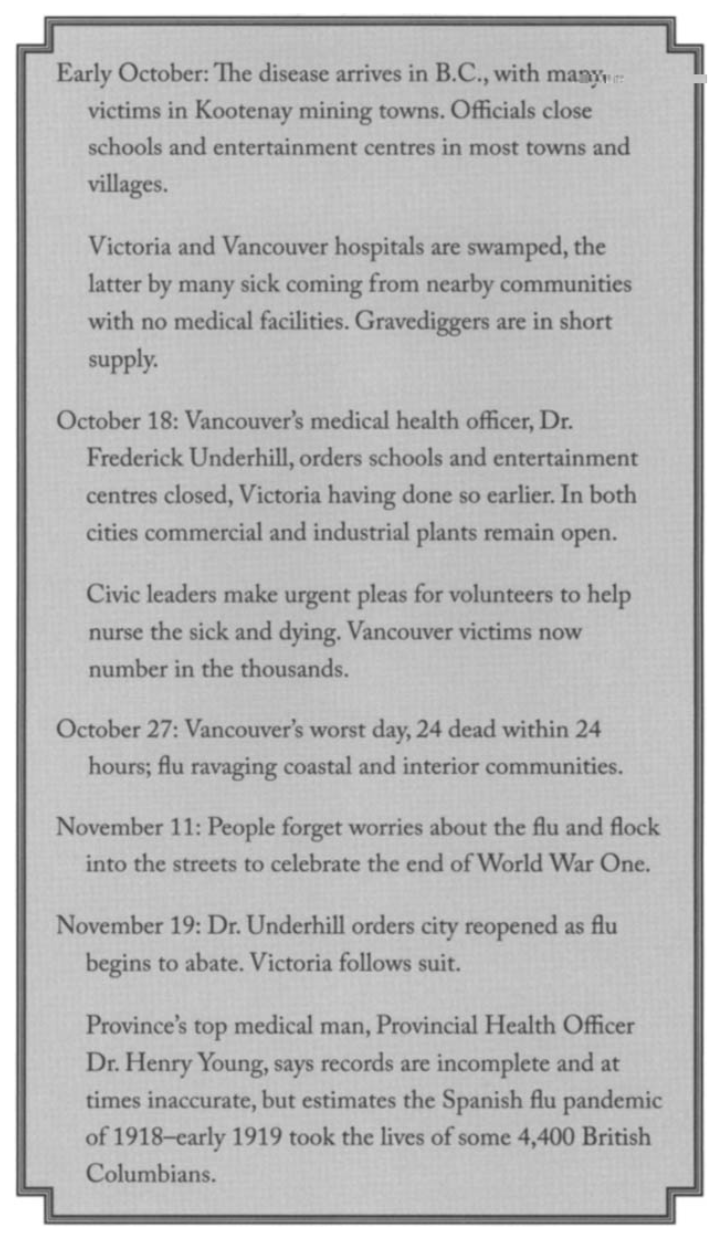
The Spread of the Flu and Movement of Soldiers
-
The Limits of Necessity: Public Health, Dissent, and the War Effort during the 1918 Influenza Pandemic notes the spread of the virus was connected to the movements of soldiers. This piece provides some great insight on the social climate at the time and the ways in which military efforts defined Canadian life. Some interesting quotes and notes follow.
-
“[Carol Byerly] suggests that military physicians and government officials were caught between their obligation to protect the public health and their duty to prosecute the war effort. According to her analysis, health and war became competing interests.” (22)
-
1st wave of flu broke out in ranks of Canadian Expeditionary Force in France and Belgium in May 1918, sickened Canadian soldiers stationed in England a month later (23)
-
Infected soldiers sailed for Canada on June 26 on the Araguaya, the last Canadian vessel to ferry wounded soldiers back across the Atlantic until the end of September (23)
-
Arrived at Halifax harbour on July 7, 23% of its soldier-passengers were infected.
-
”The second and more deadly wave of the flu first appeared among American soldiers at Camp Devens outside of Boston on 8 Sept. 1918. By the month’s second week, it had already spread across Massachusetts and into New York State.” (26)
-
17 September→ broke out among Polish American recruits at a camp outside of Niagara-on-the-Lake
- 20 September→ soldiers began reporting sick at St. Jean Military Hospital.
- “In the midst of this crisis, MacPhail requested her father’s permission to sign on for active VAD service. Now a certified VAD nursing assistant, she argued that the city was “crying out for helpers and being young and strong I feel I ought to” despite the fact that the flu showed no respect for youth.” (54)
- “In this era, Nancy Bristow argues, there was a presumption that women, whatever their nursing qualifications, would put themselves in harm’s way to fulfill their natural caring role. Certainly, many women came forward to nurse influenza victims, despite the risk to themselves.” (57)
Useful Links for the Spanish Flu
1918 Influenza Pandemic (Nature.com)
The Great Pandemic: The United States in 1918-1919
The Deadly Virus: The Influenza Epidemic of 1918
1918 Flu Pandemic That Killed 50 Million Originated in China, Historians Say
The Toronto Star - Spanish Flu Killed Millions but Few Remember
Report on Scientists Attempting to Recreate the Flu Today
Contagion: Historical Views of Diseases and Epidemics
Other Global Pandemics
The Black Death, or Bubonic Plague
The Black Plague - BBC Documentary
Smallpox
SARS
H1N1/Swine Flu/Bird Flu
What is H1N1?
Influenza viruses are split up into three broad groups known as influenza A, B and C. Influenza A is the most common type, and H1N1 is a type of influenza A. The designation “H1N1” indicates unique traits, which exhibit characteristics that identify the virus to the immune system and allows for attachment and replication of the virus. The “H” (hemagglutinin) and the “N” (neuraminidases) are both proteins that are found on the outer shell or envelope of the virus. Different viruses have different hemagglutinin and neuraminidase proteins. There are 16(H1 to H16) known types of hemagglutinin and 9(N1 to N9) known types of neuraminidase, which gives 144 different possible combinations of these proteins.
-Morgridge Institute for Research
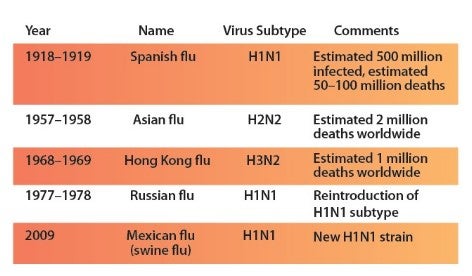
This table shows different categories of flu viruses, when they occurred, and how many people died.
Videos
The Great Influenza Outbreak of 1918
Avian Flu
Turning Points of History: Kiss of the Spanish Lady
Images
